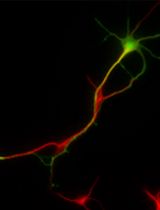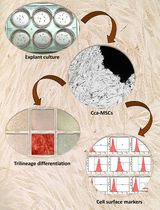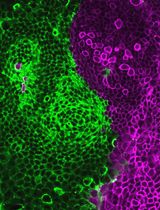- EN - English
- CN - 中文
Monitoring Intestinal Organoid–Derived Monolayer Barrier Functions with Electric Cell–Substrate Impedance Sensing (ECIS)
使用细胞-基质电阻抗感应(ECIS)监测肠道类器官衍生的单层屏障功能
发布: 2024年03月05日第14卷第5期 DOI: 10.21769/BioProtoc.4947 浏览次数: 1880
评审: Philipp WörsdörferValeria Fernandez ValloneAnonymous reviewer(s)
Abstract
The measurement of transepithelial electrical resistance across confluent cell monolayer systems is the most commonly used technique to study intestinal barrier development and integrity. Electric cell substrate impedance sensing (ECIS) is a real-time, label-free, impedance-based method used to study various cell behaviors such as cell growth, viability, migration, and barrier function in vitro. So far, the ECIS technology has exclusively been performed on cell lines. Organoids, however, are cultured from tissue-specific stem cells, which better recapitulate cell functions and the heterogeneity of the parent tissue than cell lines and are therefore more physiologically relevant for research and modeling of human diseases. In this protocol paper, we demonstrate that ECIS technology can be successfully applied on 2D monolayers generated from patient-derived intestinal organoids.
Key features
• We present a protocol that allows the assessment of various cell functions, such as proliferation and barrier formation, with ECIS on organoid-derived monolayers.
• The protocol facilitates intestinal barrier research on patient tissue-derived organoids, providing a valuable tool for disease modeling.
Background
The intestinal epithelium is represented as a cellular monolayer that separates the luminal content from the rest of the body [1]. Apart from enabling digestion and absorption of food, it serves as a crucial barrier for warding off potentially pathogenic microbes [1]. Damage and impairment of the gut barrier are observed through the course of various intestinal diseases such as necrotizing enterocolitis and inflammatory bowel disease [2,3].
A major boost to the in vitro modeling of the intestinal epithelial barrier came with the emergence of organoid technology. Organoids are self-organizing, three-dimensional (3D) structures that are grown in vitro from stem cells [4]. They recapitulate many structural and functional aspects of their parent organ more accurately than the commonly used two-dimensional (2D) cell lines [4]. Therefore, organoids have become a frequently used model among researchers. Since it remains challenging to study epithelial barrier formation in 3D structures, several studies cultured the intestinal organoids as a monolayer in a Transwell system [1].
The Transwell system is the most commonly used in vitro model for intestinal barrier research [5,6]. It consists of a porous cell culture insert that can be placed in a traditional cell culture well plate [5]. The gut epithelial cells are grown on the permeable membrane of the insert to create a cell monolayer with a luminal and basolateral compartment. Evaluation of barrier formation is assessed by measuring the transepithelial electrical resistance (TEER) with electrodes placed on either side of the membrane [5,6]. While measuring TEER with the typical handheld chopstick electrode epithelial voltohmmeter (EVOM) device remains the gold standard for assessing the integrity of barrier models, this technique requires removal of the cultures from the incubator to test each well individually. Such approach might disrupt the cell layers and, in addition, variations in electrode positioning could hinder reproducibility of measurement because of non-uniform electric field created by the chopstick electrodes [6].
An alternative to EVOM is electrical cell–substrate impedance sensing (ECIS). ECIS uses the same principle as the EVOM, except that the electrodes are integrated into the bottom of the well on which the cells are grown [6]. The presence of the electrodes in the wells allows cells to attach and proliferate directly on top of the electrodes, resulting in more localized and sensitive impedance measurements of the cell barrier. The ECIS enables impedance measurements at a broad scale of electrical frequencies, ranging from 62.5 Hz to 64 kHz. In addition, depending on the electrode placement and size, the ECIS can be used to determine additional properties of the epithelial cell layer such as cell attachment, migration, and proliferation [6]. Studying cell attachment, proliferation, and spreading yields insights into fundamental cellular behaviors, enhancing our understanding of basic biological processes in health and disease. Apart from monitoring cell barrier formation, the cells can be subjected to (lethal) electrical currents to inflict cellular damage [7]. The ECIS is therefore a potentially interesting cell-based system to study gut barrier formation and to screen for drugs capable of resolving cell damage and achieving higher mucosal healing rates. Here, we show that the ECIS technology can be successfully applied on gut organoid 2D monolayers.
Materials and reagents
Biological materials
Established 3D intestinal organoid lines isolated from either fetal (gestational age 18–22 weeks) or adult tissue (see general note 1)
Reagents
Advanced DMEM/F12 (Gibco, catalog number: 12634-028)
GlutaMAX 100× (Gibco, catalog number: 35050-038)
HEPES 1 M (Gibco, catalog number: 15630-056)
Penicillin-streptomycin (Pen/strep) 10,000 U/mL (Gibco, catalog number: 15140-122)
Glacial acetic acid (VWR, catalog number: 1.00056.2500)
L-cysteine (Sigma-Aldrich, catalog number: C7352)
Collagen type I, rat tail, 5 mg/mL (IBIDI, catalog number: 50201)
TrypLE express (1×), phenol red (Gibco, catalog number: 12605036)
Y27632 (ROCK-inhibitor) (Sigma-Aldrich, catalog number: Y0503)
Human IntestiCult organoid growth medium (includes 50 mL of IntestiCultTM OGM human basal medium and 50 mL of organoid supplement) (Stemcell Technologies, catalog number: 06010)
Human IntestiCult organoid differentiation medium (includes 50 mL of IntestiCultTM ODM human basal medium and 50 mL of organoid supplement) (Stemcell Technologies, catalog number: 100-0214)
Solutions
Ad-DF+++ (see Recipes)
Human IntestiCultTM organoid growth medium (see Recipes)
Human IntestiCultTM organoid differentiation medium (see Recipes)
100 mM L-cysteine (see Recipes)
0.1% acetic acid solution (see Recipes)
Collagen/0.1% acetic acid solution (see Recipes)
Recipes
Media preparations
Ad-DF+++
Supplement 500 mL of advanced DMEM/F12 with 5 mL of Pen/strep, 5 mL of HEPES, and 5 mL of GlutaMAX.
Human IntestiCultTM organoid growth medium
Combine 50 mL of IntestiCultTM OGM human basal medium with 50 mL of organoid supplement and 1 mL of Pen/strep.
Human IntestiCultTM organoid differentiation medium
Combine 50 mL of IntestiCultTM ODM human basal medium with 50 mL of organoid supplement and 1 mL of Pen/strep.
Coating solutions
100 mM L-cysteine
Dissolve 12.12 mg of L-cysteine in 1 mL of Milli-Q water. Pass the solution through a 0.2 µm syringe sterilization filter. The solution can be kept in the fridge for up to two weeks. Dilute the stock solution 10× in sterile Milli-Q water before the start of the experiment.
0.1% acetic acid solution
Add 25 µL of acetic acid to 25 mL of Milli-Q water. Pass the solution through a 0.2 µm syringe sterilization filter.
Collagen/0.1% acetic acid solution
Wells should be coated with 10 µg collagen/cm2. Each well has a growth area of 0.8 cm2. For 17 wells (16 wells + 1 extra), add 27.2 µL of collagen type I to 5,072.8 µL of 0.1% acetic acid solution.
Laboratory supplies
Applied BioPhysics ECIS 8W1E array (Ibidi, catalog number: 72001)
Applied BioPhysics ECIS 8W10E array (Ibidi, catalog number: 72010)
15 mL tubes (Falcon, catalog number: 352096)
0.2 µm syringe sterilization filters (Sarstedt, catalog number: 83.1826.001)
15 mL tubes (Falcon, catalog number: 352096)
200 µL pipette tips (Sapphire, catalog number: 775355)
1,000 µL pipette tips (Sapphire, catalog number: 777355)
Equipment
ECIS® Z-Theta instrument (Applied Biophysics, catalog number: 71617)
16-well array module housed in incubator including 8W test array (Applied Biophysics, catalog number: 71612)
Cell culture equipment (centrifuge, incubator, pipets, sterile hood, etc.)
Software and datasets
ECIS Zθ software (Applied Biophysics)
(Optional) Excel
(Optional) GraphPad Prism
Procedure
文章信息
版权信息
© 2024 The Author(s); This is an open access article under the CC BY license (https://creativecommons.org/licenses/by/4.0/).
如何引用
Ouahoud, S., Giugliano, F. P. and Muncan, V. (2024). Monitoring Intestinal Organoid–Derived Monolayer Barrier Functions with Electric Cell–Substrate Impedance Sensing (ECIS). Bio-protocol 14(5): e4947. DOI: 10.21769/BioProtoc.4947.
分类
细胞生物学 > 细胞分离和培养 > 单层培养
细胞生物学 > 基于细胞的分析方法
您对这篇实验方法有问题吗?
在此处发布您的问题,我们将邀请本文作者来回答。同时,我们会将您的问题发布到Bio-protocol Exchange,以便寻求社区成员的帮助。
提问指南
+ 问题描述
写下详细的问题描述,包括所有有助于他人回答您问题的信息(例如实验过程、条件和相关图像等)。
Share
Bluesky
X
Copy link












